Honglei Zhang
Learn to Preserve Personality: Federated Foundation Models in Recommendations
Jun 13, 2025Abstract:A core learning challenge for existed Foundation Models (FM) is striking the tradeoff between generalization with personalization, which is a dilemma that has been highlighted by various parameter-efficient adaptation techniques. Federated foundation models (FFM) provide a structural means to decouple shared knowledge from individual specific adaptations via decentralized processes. Recommendation systems offer a perfect testbed for FFMs, given their reliance on rich implicit feedback reflecting unique user characteristics. This position paper discusses a novel learning paradigm where FFMs not only harness their generalization capabilities but are specifically designed to preserve the integrity of user personality, illustrated thoroughly within the recommendation contexts. We envision future personal agents, powered by personalized adaptive FMs, guiding user decisions on content. Such an architecture promises a user centric, decentralized system where individuals maintain control over their personalized agents.
CoDTS: Enhancing Sparsely Supervised Collaborative Perception with a Dual Teacher-Student Framework
Dec 12, 2024



Abstract:Current collaborative perception methods often rely on fully annotated datasets, which can be expensive to obtain in practical situations. To reduce annotation costs, some works adopt sparsely supervised learning techniques and generate pseudo labels for the missing instances. However, these methods fail to achieve an optimal confidence threshold that harmonizes the quality and quantity of pseudo labels. To address this issue, we propose an end-to-end Collaborative perception Dual Teacher-Student framework (CoDTS), which employs adaptive complementary learning to produce both high-quality and high-quantity pseudo labels. Specifically, the Main Foreground Mining (MFM) module generates high-quality pseudo labels based on the prediction of the static teacher. Subsequently, the Supplement Foreground Mining (SFM) module ensures a balance between the quality and quantity of pseudo labels by adaptively identifying missing instances based on the prediction of the dynamic teacher. Additionally, the Neighbor Anchor Sampling (NAS) module is incorporated to enhance the representation of pseudo labels. To promote the adaptive complementary learning, we implement a staged training strategy that trains the student and dynamic teacher in a mutually beneficial manner. Extensive experiments demonstrate that the CoDTS effectively ensures an optimal balance of pseudo labels in both quality and quantity, establishing a new state-of-the-art in sparsely supervised collaborative perception.
A Tutorial of Personalized Federated Recommender Systems: Recent Advances and Future Directions
Dec 11, 2024Abstract:Personalization stands as the cornerstone of recommender systems (RecSys), striving to sift out redundant information and offer tailor-made services for users. However, the conventional cloud-based RecSys necessitates centralized data collection, posing significant risks of user privacy breaches. In response to this challenge, federated recommender systems (FedRecSys) have emerged, garnering considerable attention. FedRecSys enable users to retain personal data locally and solely share model parameters with low privacy sensitivity for global model training, significantly bolstering the system's privacy protection capabilities. Within the distributed learning framework, the pronounced non-iid nature of user behavior data introduces fresh hurdles to federated optimization. Meanwhile, the ability of federated learning to concurrently learn multiple models presents an opportunity for personalized user modeling. Consequently, the development of personalized FedRecSys (PFedRecSys) is crucial and holds substantial significance. This tutorial seeks to provide an introduction to PFedRecSys, encompassing (1) an overview of existing studies on PFedRecSys, (2) a comprehensive taxonomy of PFedRecSys spanning four pivotal research directions-client-side adaptation, server-side aggregation, communication efficiency, privacy and protection, and (3) exploration of open challenges and promising future directions in PFedRecSys. This tutorial aims to establish a robust foundation and spark new perspectives for subsequent exploration and practical implementations in the evolving realm of RecSys.
Learning to Hash for Recommendation: A Survey
Dec 05, 2024



Abstract:With the explosive growth of users and items, Recommender Systems (RS) are facing unprecedented challenges on both retrieval efficiency and storage cost. Fortunately, Learning to Hash (L2H) techniques have been shown as a promising solution to address the two dilemmas, whose core idea is encoding high-dimensional data into compact hash codes. To this end, L2H for RS (HashRec for short) has recently received widespread attention to support large-scale recommendations. In this survey, we present a comprehensive review of current HashRec algorithms. Specifically, we first introduce the commonly used two-tower models in the recall stage and identify two search strategies frequently employed in L2H. Then, we categorize prior works into two-tier taxonomy based on: (i) the type of loss function and (ii) the optimization strategy. We also introduce some commonly used evaluation metrics to measure the performance of HashRec algorithms. Finally, we shed light on the limitations of the current research and outline the future research directions. Furthermore, the summary of HashRec methods reviewed in this survey can be found at \href{https://github.com/Luo-Fangyuan/HashRec}{https://github.com/Luo-Fangyuan/HashRec}.
Advancing Sustainability via Recommender Systems: A Survey
Nov 12, 2024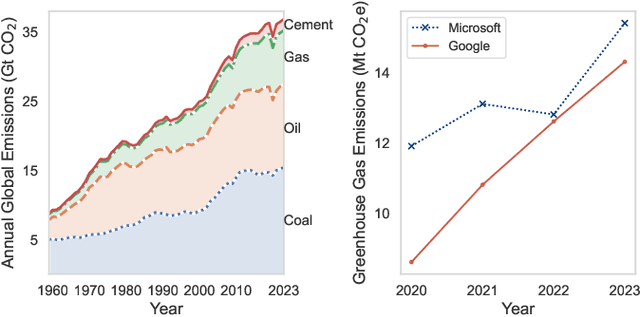
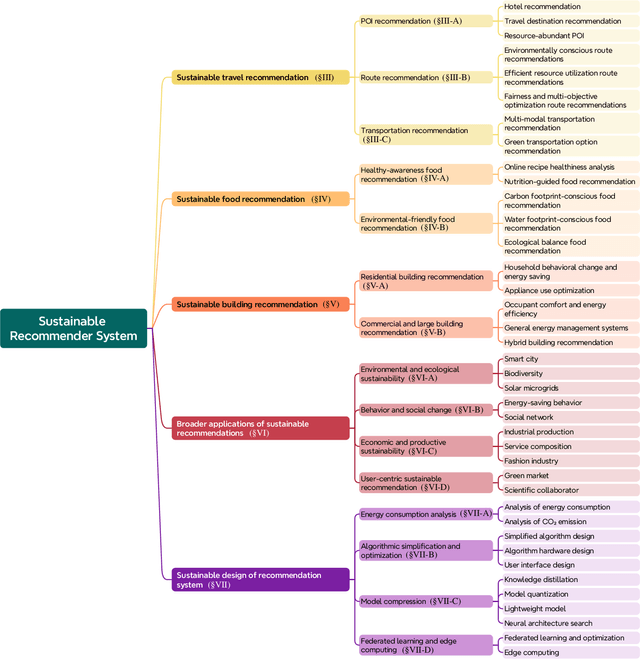
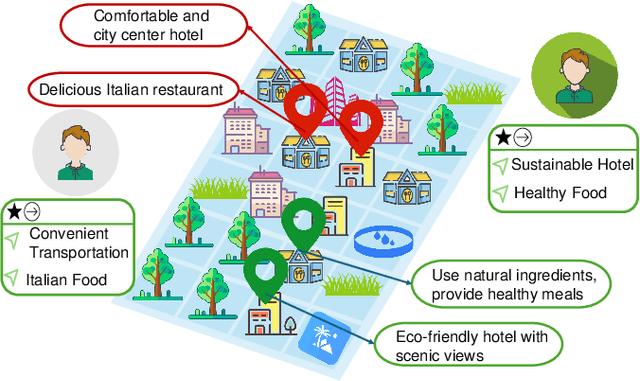
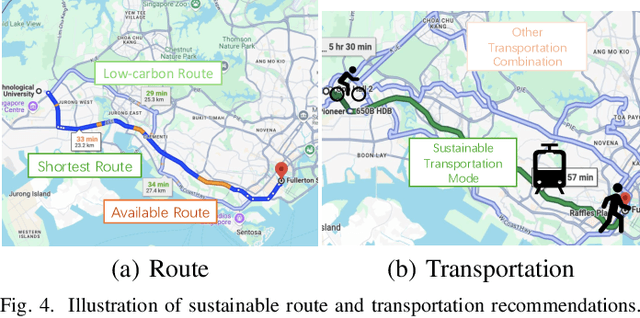
Abstract:Human behavioral patterns and consumption paradigms have emerged as pivotal determinants in environmental degradation and climate change, with quotidian decisions pertaining to transportation, energy utilization, and resource consumption collectively precipitating substantial ecological impacts. Recommender systems, which generate personalized suggestions based on user preferences and historical interaction data, exert considerable influence on individual behavioral trajectories. However, conventional recommender systems predominantly optimize for user engagement and economic metrics, inadvertently neglecting the environmental and societal ramifications of their recommendations, potentially catalyzing over-consumption and reinforcing unsustainable behavioral patterns. Given their instrumental role in shaping user decisions, there exists an imperative need for sustainable recommender systems that incorporate sustainability principles to foster eco-conscious and socially responsible choices. This comprehensive survey addresses this critical research gap by presenting a systematic analysis of sustainable recommender systems. As these systems can simultaneously advance multiple sustainability objectives--including resource conservation, sustainable consumer behavior, and social impact enhancement--examining their implementations across distinct application domains provides a more rigorous analytical framework. Through a methodological analysis of domain-specific implementations encompassing transportation, food, buildings, and auxiliary sectors, we can better elucidate how these systems holistically advance sustainability objectives while addressing sector-specific constraints and opportunities. Moreover, we delineate future research directions for evolving recommender systems beyond sustainability advocacy toward fostering environmental resilience and social consciousness in society.
Competitive Learning for Achieving Content-specific Filters in Video Coding for Machines
Jun 18, 2024Abstract:This paper investigates the efficacy of jointly optimizing content-specific post-processing filters to adapt a human oriented video/image codec into a codec suitable for machine vision tasks. By observing that artifacts produced by video/image codecs are content-dependent, we propose a novel training strategy based on competitive learning principles. This strategy assigns training samples to filters dynamically, in a fuzzy manner, which further optimizes the winning filter on the given sample. Inspired by simulated annealing optimization techniques, we employ a softmax function with a temperature variable as the weight allocation function to mitigate the effects of random initialization. Our evaluation, conducted on a system utilizing multiple post-processing filters within a Versatile Video Coding (VVC) codec framework, demonstrates the superiority of content-specific filters trained with our proposed strategies, specifically, when images are processed in blocks. Using VVC reference software VTM 12.0 as the anchor, experiments on the OpenImages dataset show an improvement in the BD-rate reduction from -41.3% and -44.6% to -42.3% and -44.7% for object detection and instance segmentation tasks, respectively, compared to independently trained filters. The statistics of the filter usage align with our hypothesis and underscore the importance of jointly optimizing filters for both content and reconstruction quality. Our findings pave the way for further improving the performance of video/image codecs.
Beyond Similarity: Personalized Federated Recommendation with Composite Aggregation
Jun 06, 2024Abstract:Federated recommendation aims to collect global knowledge by aggregating local models from massive devices, to provide recommendations while ensuring privacy. Current methods mainly leverage aggregation functions invented by federated vision community to aggregate parameters from similar clients, e.g., clustering aggregation. Despite considerable performance, we argue that it is suboptimal to apply them to federated recommendation directly. This is mainly reflected in the disparate model architectures. Different from structured parameters like convolutional neural networks in federated vision, federated recommender models usually distinguish itself by employing one-to-one item embedding table. Such a discrepancy induces the challenging embedding skew issue, which continually updates the trained embeddings but ignores the non-trained ones during aggregation, thus failing to predict future items accurately. To this end, we propose a personalized Federated recommendation model with Composite Aggregation (FedCA), which not only aggregates similar clients to enhance trained embeddings, but also aggregates complementary clients to update non-trained embeddings. Besides, we formulate the overall learning process into a unified optimization algorithm to jointly learn the similarity and complementarity. Extensive experiments on several real-world datasets substantiate the effectiveness of our proposed model. The source codes are available at https://github.com/hongleizhang/FedCA.
TransFR: Transferable Federated Recommendation with Pre-trained Language Models
Feb 02, 2024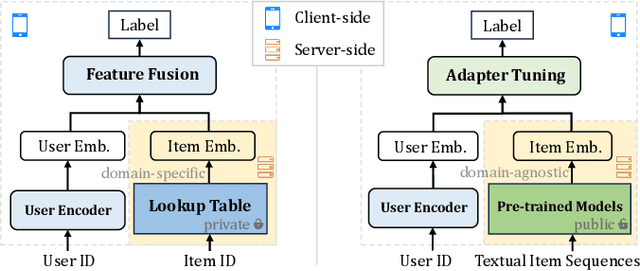

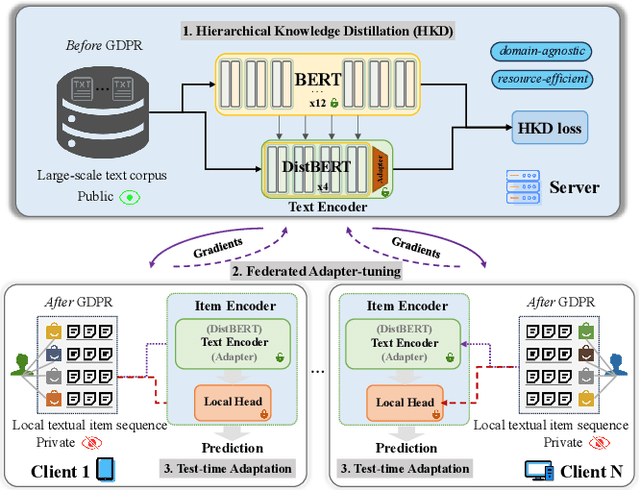

Abstract:Federated recommendations (FRs), facilitating multiple local clients to collectively learn a global model without disclosing user private data, have emerged as a prevalent architecture for privacy-preserving recommendations. In conventional FRs, a dominant paradigm is to utilize discrete identities to represent users/clients and items, which are subsequently mapped to domain-specific embeddings to participate in model training. Despite considerable performance, we reveal three inherent limitations that can not be ignored in federated settings, i.e., non-transferability across domains, unavailability in cold-start settings, and potential privacy violations during federated training. To this end, we propose a transferable federated recommendation model with universal textual representations, TransFR, which delicately incorporates the general capabilities empowered by pre-trained language models and the personalized abilities by fine-tuning local private data. Specifically, it first learns domain-agnostic representations of items by exploiting pre-trained models with public textual corpora. To tailor for federated recommendation, we further introduce an efficient federated fine-tuning and a local training mechanism. This facilitates personalized local heads for each client by utilizing their private behavior data. By incorporating pre-training and fine-tuning within FRs, it greatly improves the adaptation efficiency transferring to a new domain and the generalization capacity to address cold-start issues. Through extensive experiments on several datasets, we demonstrate that our TransFR model surpasses several state-of-the-art FRs in terms of accuracy, transferability, and privacy.
Bridging the gap between image coding for machines and humans
Jan 19, 2024Abstract:Image coding for machines (ICM) aims at reducing the bitrate required to represent an image while minimizing the drop in machine vision analysis accuracy. In many use cases, such as surveillance, it is also important that the visual quality is not drastically deteriorated by the compression process. Recent works on using neural network (NN) based ICM codecs have shown significant coding gains against traditional methods; however, the decompressed images, especially at low bitrates, often contain checkerboard artifacts. We propose an effective decoder finetuning scheme based on adversarial training to significantly enhance the visual quality of ICM codecs, while preserving the machine analysis accuracy, without adding extra bitcost or parameters at the inference phase. The results show complete removal of the checkerboard artifacts at the negligible cost of -1.6% relative change in task performance score. In the cases where some amount of artifacts is tolerable, such as when machine consumption is the primary target, this technique can enhance both pixel-fidelity and feature-fidelity scores without losing task performance.
NN-VVC: Versatile Video Coding boosted by self-supervisedly learned image coding for machines
Jan 19, 2024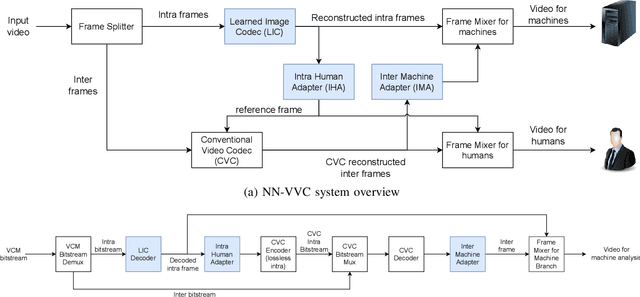
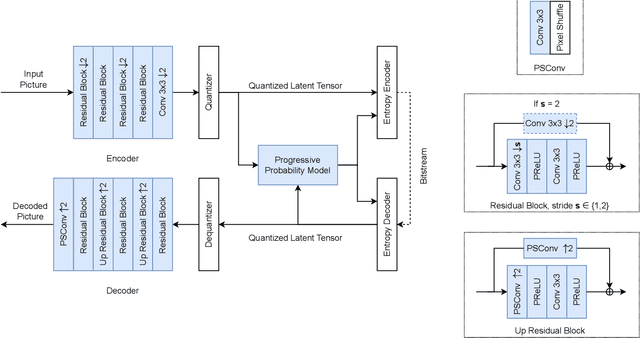


Abstract:The recent progress in artificial intelligence has led to an ever-increasing usage of images and videos by machine analysis algorithms, mainly neural networks. Nonetheless, compression, storage and transmission of media have traditionally been designed considering human beings as the viewers of the content. Recent research on image and video coding for machine analysis has progressed mainly in two almost orthogonal directions. The first is represented by end-to-end (E2E) learned codecs which, while offering high performance on image coding, are not yet on par with state-of-the-art conventional video codecs and lack interoperability. The second direction considers using the Versatile Video Coding (VVC) standard or any other conventional video codec (CVC) together with pre- and post-processing operations targeting machine analysis. While the CVC-based methods benefit from interoperability and broad hardware and software support, the machine task performance is often lower than the desired level, particularly in low bitrates. This paper proposes a hybrid codec for machines called NN-VVC, which combines the advantages of an E2E-learned image codec and a CVC to achieve high performance in both image and video coding for machines. Our experiments show that the proposed system achieved up to -43.20% and -26.8% Bj{\o}ntegaard Delta rate reduction over VVC for image and video data, respectively, when evaluated on multiple different datasets and machine vision tasks. To the best of our knowledge, this is the first research paper showing a hybrid video codec that outperforms VVC on multiple datasets and multiple machine vision tasks.
 Add to Chrome
Add to Chrome Add to Firefox
Add to Firefox Add to Edge
Add to Edge